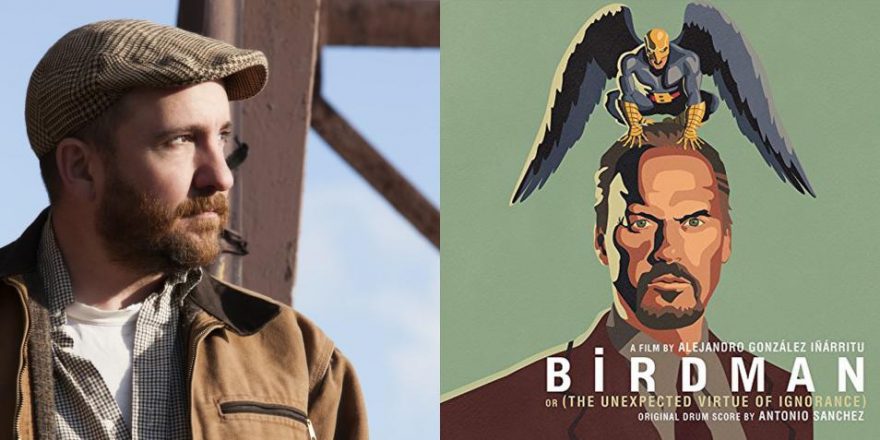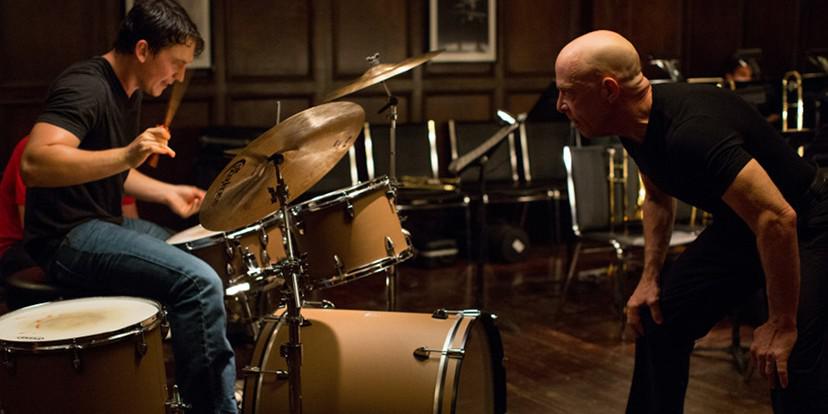Now, according to illustrious Talkhouse editor Michael Azerrad, I am uniquely unqualified to write this article because I am “not a drums person.” He says the last snare sound I recorded with any impact was at least 10 years ago. My recent records have featured mainly electronic percussion, or tablas. Hyperacusis in my left ear prevents me from sharing the stage with a tambourine, let alone a drum kit. I have to use baggage handler-style isolation headphones to record an acoustic guitar. And then Mr. Azerrad flatters me that I am known as a melody person, and that drums have no melody.
No melody!?! To that I say, “Hah!” If drums didn’t have melody, we wouldn’t have to spend so much time tuning them! A drum kit is just a squishier marimba with fewer notes and disposable sticks, surrounded by trash-can lids.
Birdman is a film seemingly shot almost entirely in one dancing, swooping tracking shot, like Hitchcock’s Rope or the opening of Welles’ Touch of Evil, only two hours long. The action is set in and around a Broadway theater, with journeys down the block, into and out of a bar and a liquor store, and into Times Square… all in one shot. (I have seen it with three audiences, and they all did some audible gasping at the sheer technical skill.) The protagonist, Riggan Thomson, is an actor whose superhero-blockbuster phase ended a decade ago, and who is now directing and starring in his own ham-fisted theatrical adaptation of Raymond Carver’s What We Talk About When We Talk About Love. As the camera glides and flutters through the backstage maze, we watch Thomson’s family, career and sense of self falling apart with the help of his ludicrous alter ego, Birdman.
But what makes the film startlingly unique, genuinely odd in fact, is that the soundtrack is, mostly, played by one guy on his drum kit. Antonio Sanchez has never scored a movie before, for the excellent reason that few if any drummers have ever scored a feature film before. Some precedents for the percussion-heavy film score include Miles Davis’s Lift to the Scaffold, Quincy Jones’ In Cold Blood and The Color Purple, and my own Eban and Charley. The most well-known non-tonal score would have to be Bebe and Louis Barron’s 1956 electronic masterpiece Forbidden Planet, which was such an aberration it could not be credited as music but as “electronic tonalities.” But I am not aware of another feature film scored on a drum kit.
Besides the drum score there are a few excerpts from existing orchestral and operatic music by John Adams, Mahler, Tchaikovsky, Ravel and Rachmaninoff, which director Alejandro González Iñnáritu uses pointedly as bleeding chunks; they typically chop off mid-note. On the soundtrack album they are clumped together at the end, so the listener can turn up the volume at the beginning of track 17, in order to hear the quieter sections. (Separate discs would have been more appropriate, but the drum score disc would have been barely 29 minutes long.)
Counter to tradition, the orchestral music is diegetic (audible to the characters), being the music selected by the protagonist to accompany his play; and the drum score is non-diegetic even though the drummer appears (seemingly) in the film. According to Entertainment Weekly, the drummer glimpsed twice in the film is not actually Sanchez, but his friend Nate Smith; Sanchez had to precisely mimic Smith’s drum hits later in the studio.
The individual cues — or, on the album, tracks — are compositionally varied, some beat-based, some in free tempo; most last less than two minutes. “Internal War” is based on virtuosic rolls and frenetic high-hat patterns, whereas “Waiting for What?” is a melodic line that gradually turns into a beat, then stops abruptly.
Sanchez is usually a mainstream jazz drummer, with purity of tone and a Zildjian cymbals endorsement; but for this project he often detuned his drums and made the cymbals sound rougher by placing smaller cymbals on top of them. Sometimes the kit was recorded outdoors, as on the track “Doors and Distance,” for which the microphones were carried towards and away from the drum kit and down the street, and then panned from speaker to speaker in the mix. There is even tape hiss audible on a few tracks, an extreme rarity in cinema since World War II or so.
The orchestral excerpts at the end of the soundtrack album range in time around the turn of the last century, from 1888 Tchaikovsky to 1914 Ravel, with the exception of John Adams’ 1991 “Prologue: Chorus of Exiled Palestinians” from The Death of Klinghoffer, recently in the news for controversy surrounding its production at the Metropolitan Opera.
Iñnáritu’s liner notes reveal how the score developed: “One week before I started the shoot in NY, Antonio Sanchez recorded, with majestic graciousness and imagination, dozens of eclectic beats based on my terrible attempts right there to explain to him with mouth rhythms (like ‘KA KA UG UG PA PASH’… he was generous enough not to laugh at me) the emotions of the characters and the needs of each scene. Antonio provided and improvised an amazing amount of possible rhythms; each one was better than the other.” These patterns informed the shooting, and were later recreated and reworked in the recording studio, with overdubbing and additional sounds integrated by sound designer and music editor Martin Hernandez.
Does it work, though? It’s never boring for an instant. Hans Zimmer’s supremely competent orchestral score for Interstellar, based on what I hear as a misunderstanding of Philip Glass, is so boring I wanted to walk out of the theater. (I do that regularly. I’m a busy boy.) But the uniqueness of Sanchez’s and Iñnáritu’s approach keeps the novelty from wearing thin over two hours. Should you hire Antonio Sanchez to score your next blockbuster space opera? How should I know?
Let’s find out!
[For director Barry Jenkins’ Talkhouse Film piece about Birdman, click here]









